Grade I listed churches in Cumbria
Cumbria is a county in North West England. It was created in 1974 from the historical counties of Westmorland and Cumberland, together with the Furness area of Lancashire and the Sedbergh Rural District of the West Riding of Yorkshire. Its largest settlement is the county town of Carlisle.[1] Buildings in England are given listed building status by the Secretary of State for Culture, Media and Sport, acting on the recommendation of Historic England.[2] Listed status gives the structure national recognition and protection against alteration or demolition without authorisation. Grade I listed buildings are defined as being of "exceptional interest, sometimes considered to be internationally important"; only 2.5 per cent of listed buildings are included in this grade.[3]
There have been Christian churches in Cumbria since the Anglo-Saxon era. Anglo-Saxon elements to be found in the churches include the lower parts of the towers of St Michael, Beetham,[4] and St Laurence, Morland.[5] Many of the churches have Norman features, including the tower of St Michael, Barton,[6] the north arcade of St Andrew, Crosby Garrett,[7] the crossing of St Lawrence, Crosby Ravensworth,[8] much of St John the Evangelist, Crosscanonby,[9] the north arcade and three doorways of St Mary, Kirkby Lonsdale,[10] and a doorway, the arcades and the chancel arch of St Michael, Torpenhow.[11] Gothic features are found in churches that originated at a later date, such as All Saints, Boltongate,[12] and in additions to older churches, such as St Lawrence, Appleby,[13] St Michael, Burgh by Sands,[14] and Carlisle Cathedral.[15] St James, Whitehaven, is in Georgian style,[16] as is the nave of St Andrew, Penrith.[17] Gothic Revival features can be found in churches that were restored or altered during the 19th century, and include the north transept added to St Michael, Muncaster by Anthony Salvin,[18] additions to St Martin, Bowness-on-Windermere by Paley and Austin,[19] and William Butterfield's restoration of St Bridget, Brigham.[20] The most modern church in the list is St Martin, Brampton, which was built between 1874 and 1878, and is the only church designed by Philip Webb, using a variety of architectural styles.[21]
Cumbria is predominantly rural, and has the largest national park in England and Wales, the Lake District. The county's major industry is tourism, but there is also some manufacturing, especially in the coastal towns of Barrow-in-Furness and Whitehaven. The geology of the county is complex: the central Lake District region contains volcanic and metamorphic rocks, with sedimentary rocks around the periphery.[22] The building materials used for the churches are mainly the sedimentary rocks of sandstone and limestone, with roofs in metamorphic slate.[23] Stone from the nearby Roman Hadrian's Wall was re-used in the construction of some churches in the north of the county, including St Andrew, Aikton,[24] St Michael, Burgh by Sands,[25] and St Peter, Kirkbampton.[26] Viking material in the form of statues and the Gosforth Cross is found in association with St Mary, Gosforth,[27] and in a wall of St Mary and St Michael, Great Urswick, is a cross-shaft thought to be Viking in origin.[28] Because of Cumbria's proximity to Scotland, several churches incorporate defensive features, including St Michael, Burgh by Sands, St Mungo, Dearham,[29] St James, Great Ormside,[30] and St John, Newton Arlosh.[31] This list consists of the 49 Grade I listed ecclesiastical buildings in the ceremonial county of Cumbria, as recorded in the National Heritage List for England.
Churches
| Name | Location | Photograph | Notes |
|---|---|---|---|
| St Mary | Abbeytown 54°50′43″N 3°16′58″W / 54.8454°N 3.2829°W |
.jpg) |
The present church consists of part of the nave of Holmcultram Abbey, a Cistercian monastery founded in 1150. A west porch was added in 1507. Following the dissolution of the monasteries in 1538, the congregation was allowed to use the building as their parish church. The tower fell in 1600, destroying the choir and the north transept, an event that was followed by a fire in 1604. The building was modified between 1727 and 1739, shortening the nave, and removing the aisles and clerestory. The church was restored in 1913, and an ambulatory was created in 1973, but the building was again damaged by fire in 2006. It is constructed in sandstone, and contains a Norman west doorway and a Perpendicular east window.[32][33] |
| St Andrew | Aikton 54°51′55″N 3°07′10″W / 54.8653°N 3.1194°W |
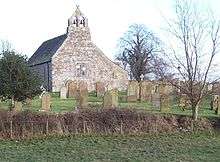 |
St Andrew's dates from the 12th century, and retains some Norman features, including the chancel arch. Stones from Hadrian's Wall were used in its construction. The east and south walls of the chancel were rebuilt in 1732, and the north and south walls of the nave rebuilt in 1869. At the west end is a double bellcote surmounted by a St Andrew's cross. The porch contains a 13th-century upside-down grave-slab.[24][34] |
| St Lawrence | Appleby-in-Westmorland 54°34′42″N 2°29′29″W / 54.5782°N 2.4915°W |
 |
The oldest part of the church is the Norman lower stage of the tower, dating from about 1130. The body of the church is from the 14th century, and is in Decorated style. The exterior of the church is in Perpendicular style. Between 1655 and 1666, the northeast chapel was added and the chancel was rebuilt, this being paid for by Lady Anne Clifford. The church was restored in 1861–62, and again in 1960. The organ was acquired from Carlisle Cathedral in 1674. In the north chapel are monuments to Lady Anne Clifford, and to her mother, Lady Margaret Clifford.[13][35] |
| St Michael | Barton 54°37′47″N 2°47′43″W / 54.6298°N 2.7954°W |
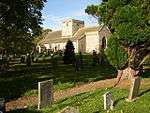 |
St Michael's has a central tower dating from the 12th century; the nave dates from the same century. The south aisle was added in the following century, a north aisle and a south chapel in about 1300, and the chancel in the early 14th century. Perpendicular-style windows were inserted in the 16th century, the south porch was added in the following century, and the vestry was built in about 1904. It is the only church in Cumbria to have a central Norman tower on a medieval parish church.[6][36] |
| St Michael | Beetham 54°12′34″N 2°46′27″W / 54.2094°N 2.7741°W |
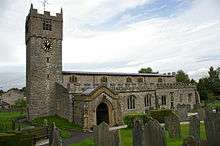 |
It is possible that the lower part of the tower of St Michael's dates from the Anglo-Saxon era. The south aisle was added in about 1200, the chancel was extended during the 13th century, and in the following century the Beetham chapel was added. The south aisle was widened in the 15th century, and in the following century the top stage of the tower was built. There was a restoration in 1873–75. The south arcade is in Norman style.[4][37] |
| All Saints | Bolton 54°36′17″N 2°33′36″W / 54.6046°N 2.5599°W |
 |
This long narrow church was built in the 12th and 13th centuries, with later alterations. It was restored in 1848. At the west end is a bellcote with a saddleback roof. The church contains Norman features, including windows and a south doorway. An early 12th-century carved stone above the doorway depicts two knights on horseback.[38][39] |
| All Saints | Boltongate 54°45′22″N 3°11′55″W / 54.7560°N 3.1986°W |
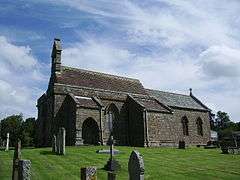 |
All Saints dates from the 14th century, replacing an earlier church. It is constructed in limestone; the roof of the nave is in sandstone slate, and that of the chancel is green slate. The plan consists of a nave with north and south porches, north and south transepts, a chancel and a north vestry. At the west end is a double bellcote. The architectural style is Perpendicular. The roof of the nave is a pointed barrel vault.[12][40] |
| St Martin | Bowness-on-Windermere 54°21′51″N 2°55′16″W / 54.3641°N 2.9210°W |
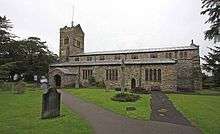 |
A chapel of ease built in 1203 was replaced by the present church in about 1483, retaining the tower base. The clerestory was probably added in the 16th century. The church was restored in 1870 by Paley and Austin, who added the saddleback roof to the tower, built the stair turret, and extended the chancel. The northeast vestry was built in 1911 by W. L. Dolman, who converted it into a chapel in 1922. Painted on the internal walls are texts dating from the 16th century, and further decoration executed by Henry Hughes in the 19th century. One of the monuments is by John Flaxman.[19][41] |
| St Martin | Brampton 54°56′30″N 2°44′16″W / 54.9417°N 2.7379°W |
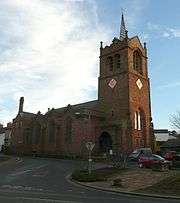 |
St Martin's was built in 1877–78. It is the only church designed by Pre-Raphaelite architect Philip Webb. The top stage of the tower, featuring a saddleback roof with a lead spirelet, was added in 1906 by George Jack, following Webb's design. The church is constructed in sandstone with green slate roofs. All the stained glass was made by Morris & Co. and designed by Edward Burne-Jones. The font, moved from another church, dates from the 13th century.[21][42] |
| St Bridget | Brigham 54°39′54″N 3°25′08″W / 54.6651°N 3.4189°W |
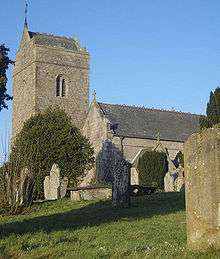 |
Originating in the 11th century, St Bridget's had alterations and additions in each of the following three centuries. Between 1864 and 1876, William Butterfield restored the church; this included adding the east window and the south windows of the chancel, as well as the saddleback roof on the tower. Inside, many of the furnishings and the floor tiles were designed by Butterfield. The stained glass in some of the windows was designed by Alexander Gibbs under Butterfield's direction.[20][43] |
| St Mungo | Bromfield 54°48′41″N 3°17′02″W / 54.8114°N 3.2840°W |
 |
St Mungo's Church dates from the 12th century, with later additions and alterations. One of the additions was the chantry chapel of St George which originated in 1395. It was suppressed at the time of the dissolution of the monasteries, and restored in 1925. The north aisle and north transept were rebuilt in 1861, creating a family chapel in the transept. The chancel was restored in 1893. On the south of the church is a re-set Norman doorway, whose tympanum consists of a re-used hogback stone. At the west end of the church is a double bellcote, and at the east end is a smaller medieval bellcote with an angelus bell.[44][45] |
| St Ninian (also known as Ninekirks) |
Brougham 54°39′46″N 2°41′05″W / 54.6628°N 2.6847°W |
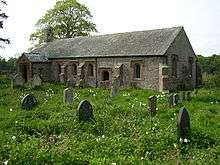 |
The church originated in the Norman era, but was completely rebuilt in 1659–60 at the expense of Lady Anne Clifford. It consists of a four-bay nave and a single-bay chancel, with a west bellcote and a south porch added in the 19th century. Almost all the furnishings date from the 17th century, including a three-decker pulpit with a sounding board, the font, and box pews. The church is now redundant and in the care of the Churches Conservation Trust.[46][47][48] |
| St Michael | Burgh by Sands 54°55′20″N 3°02′56″W / 54.9221°N 3.0489°W |
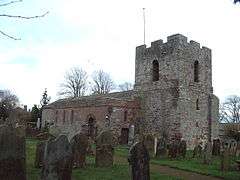 |
Built in stone from Hadrian's Wall, the church probably dates from the late 12th century. The north aisle was added in around 1200. During the 14th century the church was lengthened by the addition of a defensive tower at each end. The east tower was reduced in height in about 1713, and the church was restored in 1880–81. The west doorway is Norman, and the rest of the medieval church is Early English in style. The top of the west tower is probably Georgian.[14][49] |
| St James | Burton-in-Kendal 54°11′09″N 2°43′16″W / 54.1859°N 2.7210°W |
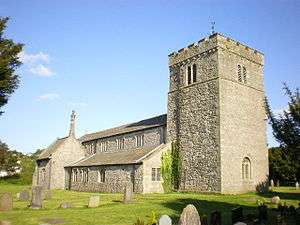 |
The lower part of the tower and the northwest corner of the nave of St James' are Norman, dating from the 12th century. Alterations and additions, including the aisles and chapels, were made during the next four centuries. The church was restored in 1844, when the chancel and north chapel were built and the clerestory added, and again in 1872. It is constructed in limestone with dressings in limestone and sandstone. The windows contain Decorated and Perpendicular tracery.[50][51] |
| St Kentigern | Caldbeck 54°44′58″N 3°02′58″W / 54.7495°N 3.0495°W |
 |
St Kentigern's was built in the 12th and 13th centuries, and retains features of Norman architecture in the south porch. Alterations were made in 1512, and in 1727 the west tower was built. The church was restored by C. J. Ferguson in 1880; work included rebuilding the chancel roof. In 1932–33 the clerestory was added by C. J. Fawcett Martindale. The tower is constructed in limestone, the body of the church in sandstone, and the roofs are in green slate.[52][53] |
| Carlisle Cathedral | Carlisle 54°53′41″N 2°56′18″W / 54.8947°N 2.9384°W |
 |
The cathedral originated as an Augustinian priory church in the 12th century. Repeated additions were made until the dissolution of the monasteries, following which the building was much reduced in size. Since then there have been restorations and alterations; in 1765 by Thomas Pitt, in 1852–56 by Ewan Christian, and in 1871–80 by G. E. Street. Later alterations were made under Charles Nicholson and S. E. Dykes Bower. The nave is in Norman style, and the choir is in a mixture of Early English and Decorated styles.[15][54] |
| St Mary | Cartmel 54°12′04″N 2°57′09″W / 54.2011°N 2.9524°W |
 |
Cartmel Priory was founded in about 1189 by the Augustinians. Following its dissolution in 1536, the whole of the priory church became the parish church. By the beginning of the 17th century it was in poor condition, and was repaired by George Preston of Holker Hall. It was restored during the 19th century, particularly between 1857 and 1870 by E. G. Paley. The church has a cruciform plan: the tower is at the crossing, with its upper stage set diagonally. There are Norman features, including a south doorway and blocked windows.[55][56] |
| St Anthony | Cartmel Fell 54°17′06″N 2°53′52″W / 54.2849°N 2.8977°W |
 |
This long, low church was built as a chapel of ease to Cartmel Priory in about 1504. Extensions were added to the north and south at the east end in about 1520. The church was restored in 1911 by John Curwen. It is constructed in roughcast stone with a slate roof. At the west end is a low tower with a saddleback roof. Inside the church is a three-sided altar rail and a three-decker pulpit. The stained glass includes fragments dating from about 1520.[57][58] |
| St Andrew | Crosby Garrett 54°28′56″N 2°25′06″W / 54.4821°N 2.4184°W |
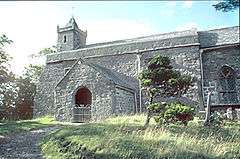 |
The church dates from the 11th century, with a Norman north arcade built in about 1175. The small west tower dates from the 13th century, and the chancel was rebuilt and enlarged in the following century. A north vestry was added in 1745. The north aisle was rebuilt in 1866 by E. Johnson in Norman Revival style. The tower was rebuilt in 1874, and has a low pyramidal roof and corner pinnacles.[7][59] |
| St Lawrence | Crosby Ravensworth 54°31′39″N 2°35′11″W / 54.5274°N 2.5865°W |
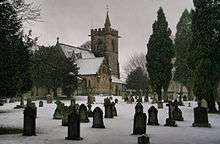 |
The oldest part of the church is at the crossing, dating from about 1190–1200. The south Norman doorway dates from the 13th century, and the west tower was built in the late 15th century. The church was remodelled twice in the 19th century; first by George Gibson in 1811–12, who added a southwest porch and a south chancel doorway. The second remodelling was carried out between 1848 and 1887 by the incumbent Revd George F. Watson in conjunction with J. S. Crowther. This included adding a new top stage to the tower, a clerestory, and transepts, and rebuilding the chancel.[8][60] |
| St John the Evangelist | Crosscanonby 54°44′14″N 3°26′50″W / 54.7373°N 3.4472°W |
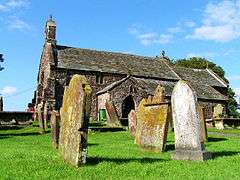 |
St John's dates from the 12th century, with alterations during the following two centuries. It was restored by C. J. Ferguson in 1880. The church is constructed in sandstone blocks, some of which came from former Roman buildings. Its architecture is mainly Norman, although the south aisle is in Decorated style. In the porch are part of a 10th-century cross-shaft decorated with carvings of beasts, and a grave-cover, possibly from the 11th century. Outside the church is a 10th-century hogback stone.[9][61] |
| St Andrew | Dacre 54°37′55″N 2°50′17″W / 54.6320°N 2.8380°W |
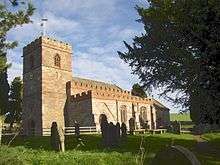 |
The church was built in the 12th century, with additions in the following century. The tower was rebuilt in 1810. There were repairs in 1854 and a restoration in 1874–75. Norman features include the tower arch and the chancel windows. In the chancel is a 12th-century piscina. Also in the church are two cross-shaft fragments, one dating from the 9th century, the other from the 10th or 11th century. In addition there are monuments, one of which is by Francis Leggatt Chantrey.[62][63] |
| St Oswald | Dean 54°36′54″N 3°26′25″W / 54.6149°N 3.4403°W |
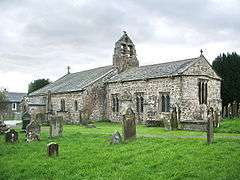 |
The church dates from the 12th century, with extensions in the 13th and 15th centuries, and alterations in the 17th century. It is constructed in calciferous sandstone, and consists of a three-bay nave, a lower and narrower three-bay chancel, and a north vestry. On the east gable of the nave is a double bellcote. Inside the church are carved furnishings by Robert (Mouseman) Thompson.[64][65] |
| St Mungo | Dearham 54°42′50″N 3°26′28″W / 54.7140°N 3.4412°W |
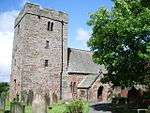 |
This Norman church was built in the late 12th century, with additions during the following century. The large tower, built for defence, dates from the 14th century. The north aisle was added by C. J. Ferguson in 1882. The font is Norman, and carved with dragon-like creatures. Also in the church are carved stones dating from the 10th and 11th centuries.[29][66] |
| St Andrew | Dent 54°16′41″N 2°27′15″W / 54.2781°N 2.4542°W |
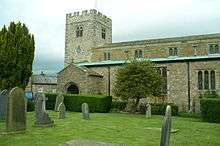 |
St Andrew's probably dates from the 12th century, and was enlarged and remodelled in the 16th century. The tower is said to have been added in the 18th century. In 1889–90, the church was restored by Paley, Austin and Paley. It is mainly in Perpendicular style. In the church is a memorial to the geologist Adam Sedgwick.[67][68] |
| St Cuthbert | Edenhall 54°40′54″N 2°40′12″W / 54.6816°N 2.6700°W |
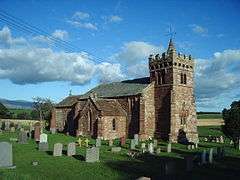 |
The church originated in the 12th century, with additions and alterations during each of the following three centuries. The tower was built in the middle of the 15th century. The church was repaired in 1662, and in 1834 the south porch and north vestry were added. The parapet of the tower has battlements, and structures similar to machicolations. On the summit of the tower is a short spire with a weathercock.[69][70] |
| St Mary | Gosforth 54°25′09″N 3°25′53″W / 54.4192°N 3.4314°W |
 |
The oldest remaining fabric in the present church dates from the 12th century, although there has been a Christian presence since the 8th century. The church was remodelled and extended between 1896 and 1899 by C. J. Ferguson. The former south Norman doorway has been blocked with stone. The church is associated with a group of Viking sculptures dating from the early 10th century, including the Gosforth Cross.[27][71] |
| St Oswald | Grasmere 54°27′27″N 3°01′25″W / 54.4575°N 3.0237°W |
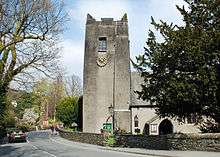 |
Dating from the 14th century, the body of the church consists of two naves, which were doubled in size between 1490 and 1500. Originally each nave had a separate roof, but these were replaced by a single roof in about 1562. The naves are divided by an arcade in two tiers; the upper tier was added when the roof was replaced. The walls and windows were restored in 1840 by George Webster. The tower is at the southeast, with walls that slope inwards. In the church is a memorial to the poet William Wordsworth by Thomas Woolner, containing an epitaph by John Keble.[72][73] |
| St James | Great Ormside 54°33′11″N 2°27′47″W / 54.5531°N 2.4631°W |
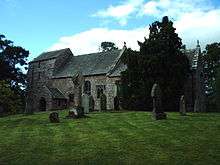 |
The nave of St James' was built in the 11th century, with a small chancel. The defensive west tower was added in about 1200; its top was later truncated. In the early 16th century the chancel was enlarged, making it wider than the nave. The north aisle was replaced in 1723 by the Hilton chapel. During the 19th century the Norman south doorway was blocked, and replaced by a new doorway and a porch immediately to the west. The font is Norman.[30][74] |
| St Mary and St Michael | Great Urswick 54°09′30″N 3°07′18″W / 54.1583°N 3.1218°W |
 |
The tower of this church dates from the 13th century, and has a Perpendicular top stage. The chancel is also from the 13th century, and was lengthened during the following century. The nave and vestry date from the 14th century. The windows contain tracery in Decorated and Perpendicular styles. A west gallery was added in 1828. When the church was restored in the early 20th century, two cross shafts were found in the walls, one of which is considered to be of Viking origin.[28][75] |
| St Michael and All Angels | Hawkshead 54°22′26″N 2°59′56″W / 54.3739°N 2.9990°W |
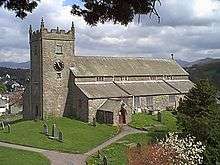 |
The church dates from the late 15th or early 16th century. The north aisle was rebuilt in 1578, becoming the Sandys Chapel, and the clerestory was added at about the same time. In about 1793 a vestry and a hearse house were added. Paintings were executed on the walls and capitals in 1680 by James Addison; these were restored in 1875–76. In the church are two memorials moved from the London Church of St Dionis Backchurch when it was demolished in the 19th century.[76][77] |
| Ireby Old Church | Ireby 54°44′34″N 3°12′26″W / 54.7427°N 3.2071°W |
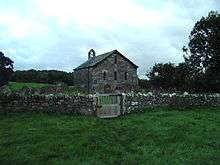 |
Only the chancel remains of this redundant church, now under the care of the Churches Conservation Trust. It was built in the 12th century and contains some Norman features. The nave, north aisle and porch were demolished in 1845–46. What remained was restored in 1880 by Ewan Christian. The chancel is constructed in blocks of sandstone and limestone, and has a green slate roof.[78][79][80] |
| St Michael | Isel 54°41′16″N 3°18′03″W / 54.6879°N 3.3009°W |
 |
Originating in the 12th century, the south doorway of the church and the chancel arch are in Norman style. The church was restored in 1878 by C. J. Ferguson. It is constructed in calciferous sandstone with slate roofs. The church consists of a four-bay nave with a south porch and a double bellcote, and a three-bay chancel with a north vestry.[81][82] |
| Holy Trinity | Kendal 54°19′21″N 2°44′39″W / 54.3225°N 2.7443°W |
 |
The church dates from the 13th century, but its present appearance is mainly the result of extensive restorations by J. S. Crowther between 1850 and 1868. It is the largest church in Cumbria, and has five aisles. Other than the west porch, and a north vestry added in 1934, the plan is a rectangle, the aisles embracing the west tower and the chancel. The architectural style is Perpendicular. In the church is a memorial to the painter George Romney.[83][84] |
| St Peter | Kirkbampton 54°53′53″N 3°05′05″W / 54.8980°N 3.0848°W |
 |
St Peter's dates from the 12th century, and contains Norman architecture. It was restored in 1870–71, and again in 1882. During these restorations, carved and inscribed stones from the nearby Roman Hadrian's Wall were found incorporated in the fabric of the south wall. The windows include stained glass designed by William Morris and Edward Burne-Jones.[26][85] |
| St Mary | Kirkby Lonsdale 54°12′13″N 2°35′51″W / 54.2037°N 2.5975°W |
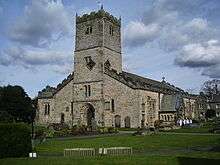 |
This church with a south aisle and two north aisles was built between the 12th and 16th centuries. Alterations were made in the 18th century and in 1807. A restoration was carried out in 1866 by E. G. Paley, which included raising the roofs and adding the south porch. Norman features include three doorways and the north arcade.[86][10][87] |
| St Mary | Lanercost 54°57′58″N 2°41′42″W / 54.9662°N 2.6949°W |
St Mary's has been converted from the nave of Lanercost Priory, the building of which started during the later part of the 1170s. After the dissolution of the monasteries, the building was in ruins until the nave was re-roofed in 1739–40. The church is constructed in sandstone taken from the nearby Hadrian's Wall. It was restored between 1847 and 1849 by Anthony Salvin, and a further restoration was carried out in the 1870s by C. J. Ferguson. The internal furnishings are mainly by Salvin and Ferguson. The stained glass in the north aisle windows was designed by Edward Burne-Jones and made by Morris & Co.[88][89] | |
| St Margaret and St James | Long Marton 54°36′36″N 2°31′04″W / 54.6100°N 2.5178°W |
 |
In the nave of St Margaret and St James' are Saxon and Norman features, including windows, and doorways with tympana containing carvings. The tower was probably built in the early 12th century, and the chancel was extended later that century. The south transept was added in the 15th century, and a vestry in the following century. The church was restored in 1880 by John A. Cory.[90][91] |
| Holy Trinity | Millom 54°13′15″N 3°16′22″W / 54.2207°N 3.2729°W |
 |
The nave and chancel of Holy Trinity date from the late 12th century, including a Norman north doorway. The south aisle was added early the following century, and was substantially enlarged in about 1335. A porch was added in 1906. The chancel was widened during a 1930 restoration, when part of a cross shaft dating from the 10th or 11th century was found built into the chancel wall. Inside the church, all the pews are box pews, and there are monuments, the oldest dating from 1484.[92][93] |
| St Laurence | Morland 54°35′47″N 2°37′25″W / 54.5965°N 2.6235°W |
 |
The tower of St Laurence's is the only Anglo-Saxon tower in the northwest of England. It was raised in height probably in 1588, and a lead-covered spire was added later. The church has a cruciform plan with Norman features. Aisles were added in the late 12th century, and the transepts in about 1225 in Early English style. In 1600 the chancel was rebuilt with Perpendicular windows. The north aisle was rebuilt in the 18th century with Georgian windows. The church was restored in 1896 by C. J. Ferguson.[5][94] |
| St Michael | Muncaster 54°21′24″N 3°22′49″W / 54.3568°N 3.3803°W |
 |
St Michael's stands in the grounds of Muncaster Castle, and dates from the 16th century. It was restored in 1873 by Anthony Salvin, who added the north transept in Decorated style, as well as battlements. Its plan consists of a four-bay nave, a three-bay chancel and a north transept. On the west gable is a double bellcote, and on the east gable is a Sanctus bellcote.[18][95] |
| St John | Newton Arlosh 54°53′08″N 3°15′02″W / 54.8855°N 3.2506°W |
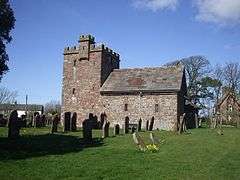 |
Built in about 1303 by the monks of Holm Cultram Abbey, the church fell into ruin after the dissolution of the monasteries. In 1844 Sarah Losh restored the church and extended it to the north In 1894 the orientation of the church was changed, turning it to the north, making the former nave into a narthex, the extension into the body of the church, and the former east apse into a vestry. The church has a defensive appearance with the tower looking like a pele.[31][96] |
| St Andrew | Penrith 54°39′51″N 2°45′04″W / 54.6642°N 2.7512°W |
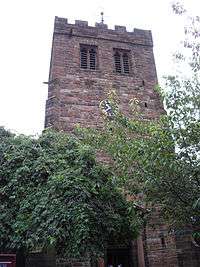 |
The lower part of the tower of St Andrew's was built in the 12th and 13th centuries, and the top stage was altered between 1460 and 1470. In 1720 the body of the church and the west doorway were rebuilt in Georgian style. Inside the church are galleries on three sides, carried on Tuscan columns, and paintings on the walls.[17][97] |
| St Oswald | Ravenstonedale 54°25′59″N 2°25′47″W / 54.4330°N 2.4296°W |
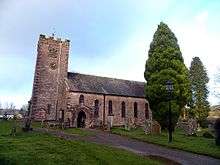 |
The tower of St Oswald's was rebuilt in 1738, and the rest of the church in 1744. It replaced an older church and re-used some of its material, including the outer doorway of the former south porch, which dated from about 1200. The church consists of a west tower, a nave without aisles, and a chancel. Inside is a west gallery. The seating is arranged in the manner of a college chapel, facing inwards, and consists of six raked ranks of box pews. In the middle of the north side is a three-decker pulpit with a sounding board.[98][99] |
| St Mary and St Bega | St Bees 54°29′38″N 3°35′36″W / 54.4939°N 3.5934°W |
St Bees Priory was founded on an existing religious site as a Benedictine priory by William Meschin sometime after 1120. Following its dissolution in 1539 the roof of the chancel was removed but the nave was retained in use as the parish church. It was repaired in 1611 and 1622. Between 1855 and the 1880s William Butterfield carried out remodelling and restoration that included re-roofing the transepts and aisles, and he re-built the upper tower in a bold Romanesque style. The fine west doorway is Norman dating from about 1140. Much of the internal furnishings are by Butterfield.[100][101] | |
| St Andrew | Sedbergh 54°19′23″N 2°31′43″W / 54.3231°N 2.5285°W |
 |
The church dates from about 1500. It was restored in 1886 by Paley and Austin. The church contains fabric from earlier periods. Its plan consists of a nave with a clerestory, north and south aisles, the north aisle extending into the vestry and the south aisle into a chapel, a chancel, and a three-stage west tower. Inside the church the arcades differ, the south having six bays, and the north eight.[102][103] |
| St Michael | Torpenhow 54°44′49″N 3°14′07″W / 54.7469°N 3.2353°W |
 |
St Michael's originated in the early 12th century and contains Norman features, including a south doorway, the arcades, the chancel arch, and the font. The north transept dates from the 13th century, and the west bellcote probably from the 17th century. In 1689 the nave ceiling was painted by Thomas Addison. The church was restored between 1880 and 1882 by John A. Cory, who also added the south porch.[11][104] |
| St Columba | Warcop 54°32′10″N 2°23′56″W / 54.5360°N 2.3988°W |
 |
The church dates from the 12th century, and contains Norman features in the north wall of the nave. Later alterations and additions resulted in the presence of Early English and Perpendicular features. The chancel was rebuilt in 1854–55 by J. S. Crowther. The church has a cruciform plan, each transept containing a piscina.[105][106] |
| St James | Whitehaven 54°33′03″N 3°35′00″W / 54.5508°N 3.5834°W |
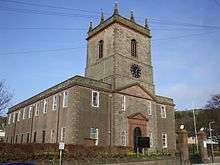 |
Built between 1752 and 1773, this church is in Georgian style. It was designed by Carlisle Spedding (or possibly by Christopher Myers). The apse was restored in 1871, and the church was reordered by C. J. Ferguson in 1886. A baptistry was created in 1921. There are galleries on three sides, and the ceiling contains roundels painted with depictions of the Annunciation and the Ascension.[16][107] |
References
Citations
- ↑ Local Government Act 1972, National Archives, retrieved 21 December 2012
- ↑ Consultation Process, Historic England, retrieved 10 July 2015
- ↑ Listed Buildings, Historic England, retrieved 25 March 2015
- 1 2 Hyde & Pevsner (2010), pp. 149–150
- 1 2 Hyde & Pevsner (2010), pp. 531–533
- 1 2 Hyde & Pevsner (2010), p. 144
- 1 2 Hyde & Pevsner (2010), p. 307
- 1 2 Hyde & Pevsner (2010), pp. 307–309
- 1 2 Hyde & Pevsner (2010), pp. 311–313
- 1 2 Hyde & Pevsner (2010), pp. 458–461
- 1 2 Hyde & Pevsner (2010), pp. 639–640
- 1 2 Hyde & Pevsner (2010), pp. 158–159
- 1 2 Hyde & Pevsner (2010), pp. 104–105
- 1 2 Hyde & Pevsner (2010), pp. 202–203
- 1 2 Hyde & Pevsner (2010), pp. 224–235
- 1 2 Hyde & Pevsner (2010), pp. 673–674
- 1 2 Hyde & Pevsner (2010), pp. 565–566
- 1 2 Hyde & Pevsner (2010), p. 534
- 1 2 Hyde & Pevsner (2010), pp. 165–167
- 1 2 Hyde & Pevsner (2010), pp. 185–186
- 1 2 Hyde & Pevsner (2010), pp. 177–179
- ↑ McMillan (2010), pp. 3–8
- ↑ Clifton-Taylor (2010), pp. 8–12
- 1 2 Hyde & Pevsner (2010), p. 90
- ↑ Hyde & Pevsner (2010), p. 202
- 1 2 Hyde & Pevsner (2010), pp. 454–455
- 1 2 Hyde & Pevsner (2010), pp. 367–369
- 1 2 Hyde & Pevsner (2010), pp. 653–655
- 1 2 Hyde & Pevsner (2010), p. 331
- 1 2 Hyde & Pevsner (2010), pp. 557–558
- 1 2 Hyde & Pevsner (2010), pp. 554–555
- ↑ Hyde & Pevsner (2010), pp. 87–88
- ↑ Historic England, "Church of St Mary, Abbeytown (1144608)", National Heritage List for England, retrieved 18 May 2012
- ↑ Historic England, "Church of St Andrew, Aikton (1327139)", National Heritage List for England, retrieved 19 May 2012
- ↑ Historic England, "Parish Church of St Lawrence, Appleby-in-Westmorland (1312067)", National Heritage List for England, retrieved 19 May 2012
- ↑ Historic England, "Church of St Michael, Barton (1326830)", National Heritage List for England, retrieved 19 May 2012
- ↑ Historic England, "Church of St Michael, Beetham (1137740)", National Heritage List for England, retrieved 17 May 2012
- ↑ Hyde & Pevsner (2010), pp. 156–157
- ↑ Historic England, "Church of All Saints, Bolton (1213959)", National Heritage List for England, retrieved 18 May 2012
- ↑ Historic England, "Church of All Saints, Boltons (1312157)", National Heritage List for England, retrieved 19 May 2012
- ↑ Historic England, "Church of St Martin, Windermere (1332562)", National Heritage List for England, retrieved 20 May 2012
- ↑ Historic England, "Church of St Martin, Brampton (1137170)", National Heritage List for England, retrieved 17 May 2012
- ↑ Historic England, "Church of St Bridget, Brigham (1145196)", National Heritage List for England, retrieved 18 May 2012
- ↑ Hyde & Pevsner (2010), p. 187
- ↑ Historic England, "Church of St Mungo, Bromfield (1235049)", National Heritage List for England, retrieved 19 May 2012
- ↑ Hyde & Pevsner (2010), p. 196
- ↑ Historic England, "Church of St Ninian, Ninekirks, Brougham (1326778)", National Heritage List for England, retrieved 19 May 2012
- ↑ St Ninan's Church, Brougham, Cumbria, Churches Conservation Trust, retrieved 19 May 2012
- ↑ Historic England, "Church of St Michael, Burgh by Sands (1367134)", National Heritage List for England, retrieved 20 May 2012
- ↑ Hyde & Pevsner (2010), pp. 208–209
- ↑ Historic England, "Church of St James, Burton-in-Kendal (1335703)", National Heritage List for England, retrieved 20 May 2012
- ↑ Hyde & Pevsner (2010), pp. 210–211
- ↑ Historic England, "Church of St Kentigern, Caldbeck (1327205)", National Heritage List for England, retrieved 19 May 2012
- ↑ Historic England, "Cathedral Church of the Holy and Undivided Trinity, Carlisle (1208430)", National Heritage List for England, retrieved 18 May 2012
- ↑ Hyde & Pevsner (2010), pp. 267–272
- ↑ Historic England, "Priory Church of St Mary, Lower Allithwaite (1335798)", National Heritage List for England, retrieved 20 May 2012
- ↑ Hyde & Pevsner (2010), pp. 273–274
- ↑ Historic England, "Church of St Anthony, Cartmel Fell (1224955)", National Heritage List for England, retrieved 18 May 2012
- ↑ Historic England, "Church of St Andrew, Crosby Garrett (1326924)", National Heritage List for England, retrieved 19 May 2012
- ↑ Historic England, "Church of St Lawrence, Crosby Ravensworth (1311870)", National Heritage List for England, retrieved 19 May 2012
- ↑ Historic England, "Church of St John, Crosscanonby (1235084)", National Heritage List for England, retrieved 19 May 2012
- ↑ Hyde & Pevsner (2010), p. 320
- ↑ Historic England, "Church of St Andrew, Dacre (1145531)", National Heritage List for England, retrieved 18 May 2012
- ↑ Hyde & Pevsner (2010), p. 329
- ↑ Historic England, "Church of St Oswald, Dean (1145164)", National Heritage List for England, retrieved 18 May 2012
- ↑ Historic England, "Church of St Mungo, Dearham (1144506)", National Heritage List for England, retrieved 18 May 2012
- ↑ Price (1998), p. 90
- ↑ Historic England, "Church of St Andrew, Dent (1383978)", National Heritage List for England, retrieved 20 May 2012
- ↑ Hyde & Pevsner (2010), pp. 337–338
- ↑ Historic England, "Church of St Cuthbert, Langwathby (1145341)", National Heritage List for England, retrieved 18 May 2012
- ↑ Historic England, "Church of St Mary, Gosforth (1063710)", National Heritage List for England, retrieved 15 May 2012
- ↑ Hyde & Pevsner (2010), pp. 374–375
- ↑ Historic England, "Church of St Oswald, Grasmere (1245157)", National Heritage List for England, retrieved 19 May 2012
- ↑ Historic England, "Church of St James, Ormside (1288923)", National Heritage List for England, retrieved 19 May 2012
- ↑ Historic England, "Church of St Mary and St Michael, Urswick (1086801)", National Heritage List for England, retrieved 17 May 2012
- ↑ Hyde & Pevsner (2010), pp. 398–399
- ↑ Historic England, "Church of St Michael and All Saints, Hawkshead (1087259)", National Heritage List for England, retrieved 17 May 2012
- ↑ Hyde & Pevsner (2010), p. 421
- ↑ Historic England, "Ireby Old Church (1144424)", National Heritage List for England, retrieved 18 May 2012
- ↑ Old Chancel, Ireby, Cumbria, Churches Conservation Trust, retrieved 18 May 2012
- ↑ Hyde & Pevsner (2010), pp. 423–424
- ↑ Historic England, "Church of St Michael, Blindcrake (1145219)", National Heritage List for England, retrieved 18 May 2012
- ↑ Hyde & Pevsner (2010), pp. 428–430
- ↑ Historic England, "Church of The Holy Trinity, Kirkgate, Kendal (1319009)", National Heritage List for England, retrieved 19 May 2012
- ↑ Historic England, "Church of St Peter, Kirkbampton (1137108)", National Heritage List for England, retrieved 17 May 2012
- ↑ Brandwood et al. (2012), p. 221
- ↑ Historic England, "Church of St Mary, Kirkby Lonsdale (1145774)", National Heritage List for England, retrieved 18 May 2012
- ↑ Hyde & Pevsner (2010), pp. 479–485
- ↑ Historic England, "Church of St Mary, Burtholme (1335636)", National Heritage List for England, retrieved 20 May 2012
- ↑ Hyde & Pevsner (2010), pp. 499–500
- ↑ Historic England, "Church of St Margaret and St James, Long Marton (1075165)", National Heritage List for England, retrieved 16 May 2012
- ↑ Hyde & Pevsner (2010), pp. 523–524
- ↑ Historic England, "Church of Holy Trinity, Millom (1086617)", National Heritage List for England, retrieved 16 May 2012
- ↑ Historic England, "Church of St Laurence, Morland (1226108)", National Heritage List for England, retrieved 18 May 2012
- ↑ Historic England, "Church of St Michael and All Angels, Muncaster (1356113)", National Heritage List for England, retrieved 20 May 2012
- ↑ Historic England, "Church of St John the Baptist, Newton Arlosh (1212611)", National Heritage List for England, retrieved 18 May 2012
- ↑ Historic England, "Parish Church of St Andrew, Eden (1145048)", National Heritage List for England, retrieved 18 May 2012
- ↑ Hyde & Pevsner (2010), pp. 585–586
- ↑ Historic England, "Church of St Oswald, Ravenstonedale (1311289)", National Heritage List for England, retrieved 19 May 2012
- ↑ Hyde & Pevsner (2010), pp. 596–599
- ↑ Historic England, "Church of St Mary and St Bega, St Bees (1336027)", National Heritage List for England, retrieved 20 May 2012
- ↑ Price (1998), p. 87
- ↑ Historic England, "Church of St Andrew, Sedbergh (1384191)", National Heritage List for England, retrieved 20 May 2012
- ↑ Historic England, "Church of St Michael, Blennerhasset and Torpenhow (1327240)", National Heritage List for England, retrieved 20 May 2012
- ↑ Hyde & Pevsner (2010), p. 660
- ↑ Historic England, "Church of St Columba, Warcop (1137446)", National Heritage List for England, retrieved 17 May 2012
- ↑ Historic England, "Church of St James the Greater, Copeland (1086747)", National Heritage List for England, retrieved 16 May 2012
Sources
- Brandwood, Geoff; Austin, Tim; Hughes, John; Price, James (2012), The Architecture of Sharpe, Paley and Austin, Swindon: English Heritage, ISBN 978-1-84802-049-8
- Clifton-Taylor, Alec (2010) [1967], "Building Materials", in Hyde, Matthew; Pevsner, Nikolaus, Cumbria, The Buildings of England, Yale University Press, ISBN 978-0-300-12663-1
- Hyde, Matthew; Pevsner, Nikolaus (2010) [1967], Cumbria, The Buildings of England, New Haven and London: Yale University Press, ISBN 978-0-300-12663-1
- McMillan, Andrew A. (2010) [1967], "Geology and Topography", in Hyde, Matthew; Pevsner, Nikolaus, Cumbria, The Buildings of England, Yale University Press, ISBN 978-0-300-12663-1
- Price, James (1998), Sharpe, Paley and Austin: A Lancaster Architectural Practice 1836–1942, Lancaster: Centre for North-West Regional Studies, ISBN 1-86220-054-8